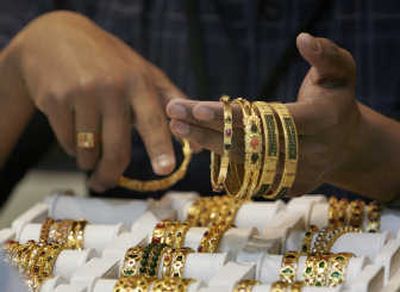Showing love on a budget

This Valentine’s Day, jewelers are latching onto a new strategy – selling less gold.
With prices for the precious metal having jumped more than 40 percent since mid-August to a record $900-plus an ounce, some jewelry stores around the country are stocking up on styles that use gold sparingly to hold down prices. The goal is to give shoppers an alternative to the sticker shock of 14-karat or 18-karat gold.
Fortunoff is carrying more pieces that feature a mix of gold and less-expensive silver, as well as lightweight “lacey” gold designs. Online retailer Blue Nile Inc. is promoting more silver jewelry and pieces that mix gold with colored gemstones or pearls, as affordable alternatives. And Tiffany & Co. has been experimenting with diamond-and-silver jewelry.
Jewelry designers started mining these techniques a couple of years ago, when gold prices started climbing. But the trend has accelerated over the past year. Prices are expected to rise further after the Feb. 14 holiday. On Wednesday, gold closed at $900.70 an ounce.
Designer John Hardy, whose collection is carried by Neiman Marcus, Saks Fifth Avenue, Nordstrom Inc. and other stores, recently introduced bracelets, necklaces and pendants that feature cut-out shapes — known in the industry as “negative space” — to reduce the amount of gold.
Designer Judith Ripka is expanding her selection of signature styles that can be purchased in smaller sizes, which can use a third less gold and cost half as much.
And Scott Kay, whose wares are sold by Saks Fifth Avenue, Bailey Banks & Biddle and boutique jewelers, is using more sterling silver as an alternative to gold and palladium as an alternative to platinum, which has also soared in price. On Wednesday, platinum closed at $1,819 an ounce in the April active futures.
The six weeks leading up to Valentine’s Day are crucial for jewelers. It’s typically their second-busiest time of year, after the Christmas rush, according to Marshal Cohen, chief industry analyst at market researcher NPD Group. The period leading up to Valentine’s Day accounts for 15 percent of annual sales, he says.
This year, even more is riding on Valentine’s Day than usual. The 2007 Christmas season was disappointing for many jewelry retailers. While jewelry sales overall rose almost 3 percent to $9.66 billion, according to Kenneth Gassman, president of the Jewelry Industry Research Institute, some big retailers suffered.
At Zale Corp., sales in November and December fell a total of 9 percent from a year earlier at stores open more than a year. Signet Group PLC, which owns Kay Jewelers in the U.S. and H. Samuel and Ernest Jones in the United Kingdom, saw same-store sales fall 6.8 percent over the Christmas period. Even upscale Tiffany felt the pinch, with U.S. same-store sales for the holiday period falling 2 percent.
Finlay Enterprises Inc., which operates jewelry departments in stores such as Lord & Taylor and Macy’s and recently bought the Bailey Banks & Biddle chain, cited higher gold prices as a factor for a decline in gross margins in its third quarter ended Nov. 3.
Some consumers are warming up to the idea of jewelry made with less gold. Bill Ditenhafer, a 38-year-old editor of a lifestyle magazine in Nashville, Tenn., who is eyeing some pieces as a Valentine’s Day gift for his wife, is thrilled that one of his wife’s favorite designers, Judith Bright, makes only gold-filled jewelry, a technique where a layer of gold is bonded onto a cheaper base metal.
“My wife loves her designs, but I also love the fact I can buy it without breaking the bank,” he says. A gold-filled 32-inch hand-hammered necklace, for example, costs $233, roughly a sixth what it would likely cost in 14-karat gold.
Some designers are trying to hit all price points. A Scott Kay men’s gothic cross bracelet costs $1,250 in silver and $16,000 in palladium. That’s far less than the $40,000 18-karat gold or $90,000 platinum versions.
Blake Riley, a 23-year-old sales associate with a packaging company near Indianapolis, is a case in point. When he bought an engagement ring a few months ago at local jeweler Reis-Nichols, he first asked to see a platinum ring, then one in white gold. He wound up choosing the same ring in palladium. The cost: $7,800, compared with $10,000 for the platinum version. “You can’t really tell the difference,” Riley says, adding that he intends to buy a palladium wedding ring for his fiancee.
But some jewelers acknowledge that by offering less-expensive alternatives, they can shoot themselves in the foot. “We don’t want to trade anyone down from platinum and diamond to white gold and diamond or silver and diamond,” Tiffany Chief Executive Michael Kowalski said in a conference call with analysts in January.
The tweaking of assortments is occurring mostly at the lower and middle range of jewelry pieces. That’s partly because the metal in an expensive piece of jewelry from a high-end retailer typically accounts for a small percent of the total cost, when adornments such as diamonds and labor are factored in.
Cartier’s Love Cuff made in 18-karat white gold, for example, has 2,649 diamonds. “On such a bracelet, the price of gold has no impact; it is irrelevant,” says Frederic de Narp, CEO of Cartier North America. “We absorb the cost, but (a higher gold price) does not affect us as much as it does a normal jeweler.”
Gold prices have risen as investors have bought the metal as a hedge against inflation and a weak U.S. dollar. While some jewelers lock in prices months in advance and haven’t yet felt the full impact of the recent price jumps, others have seen their margins squeezed.
Prices will likely continue rising, since jewelers typically order products at least four months in advance. Signet, in fact, said recently that it expects to “realign” prices after Valentine’s Day to reflect higher commodity prices.